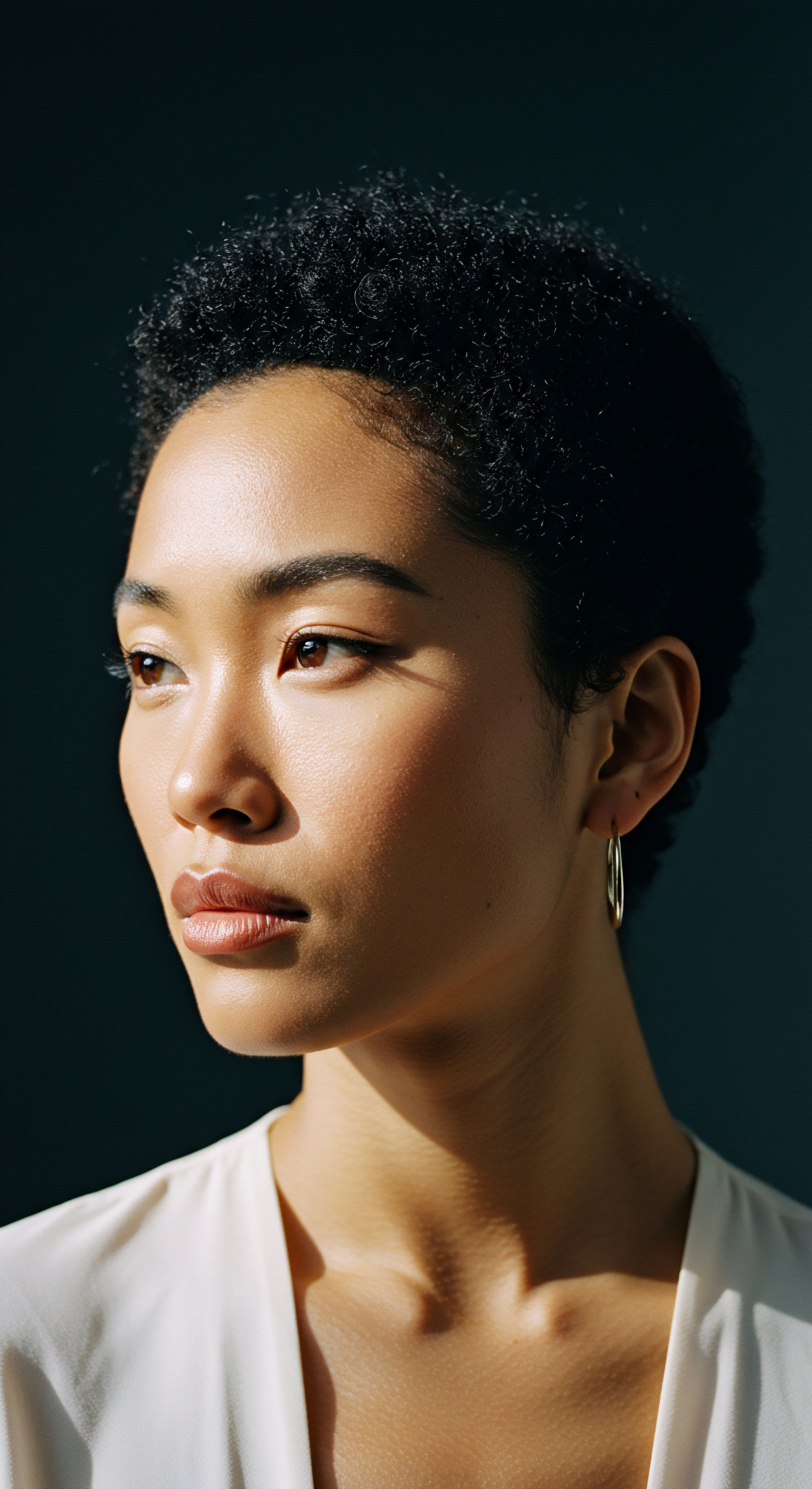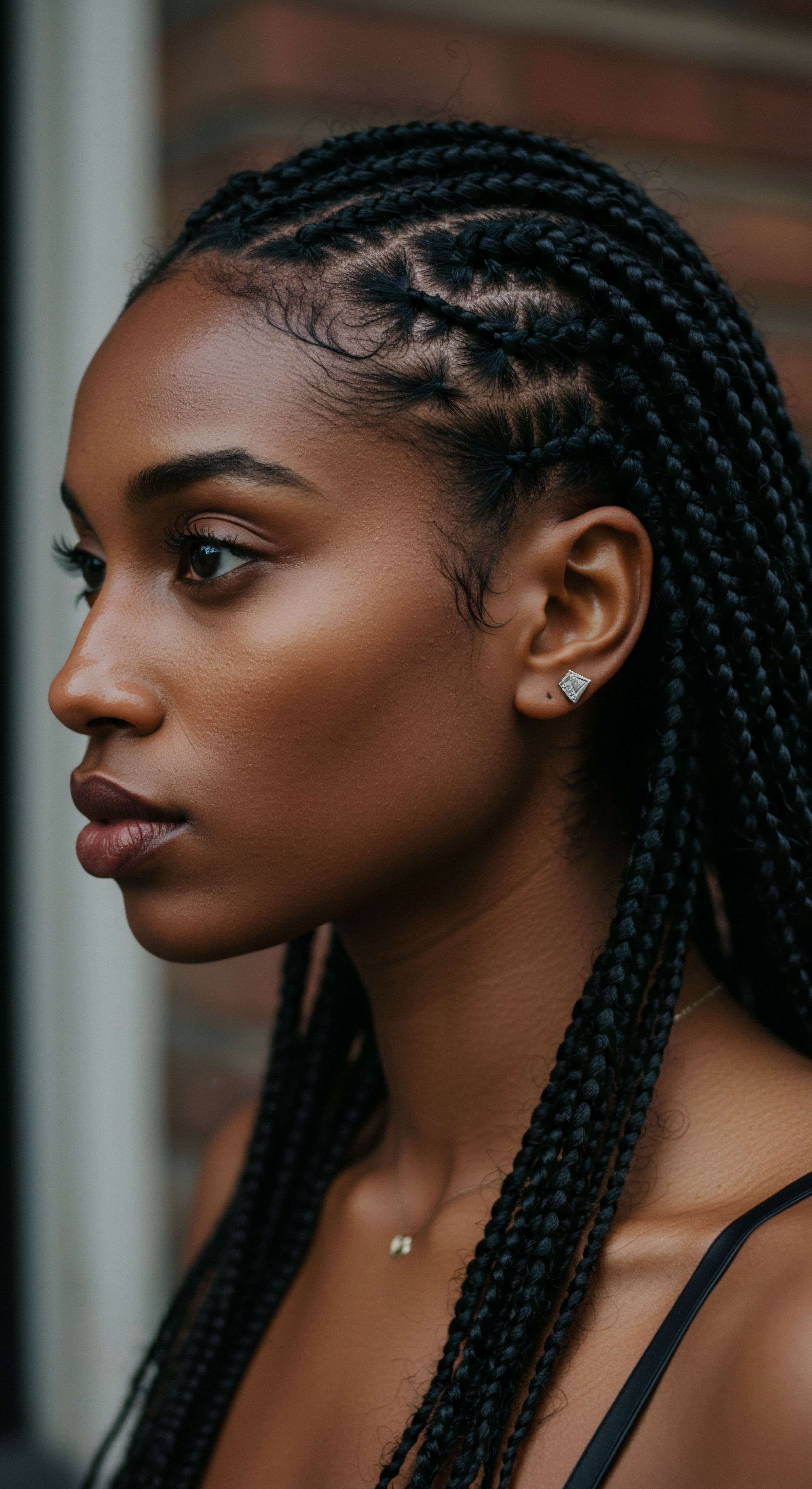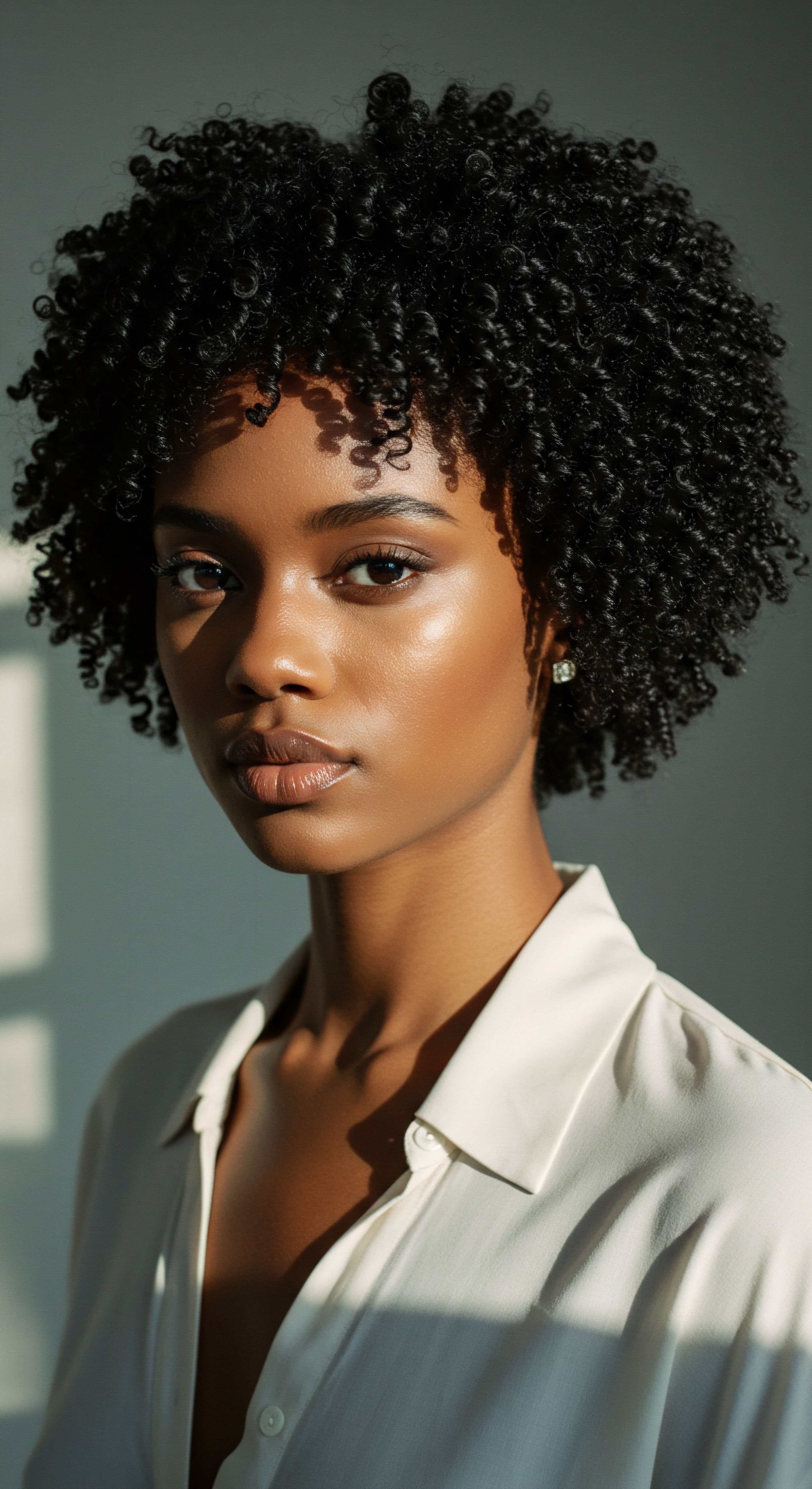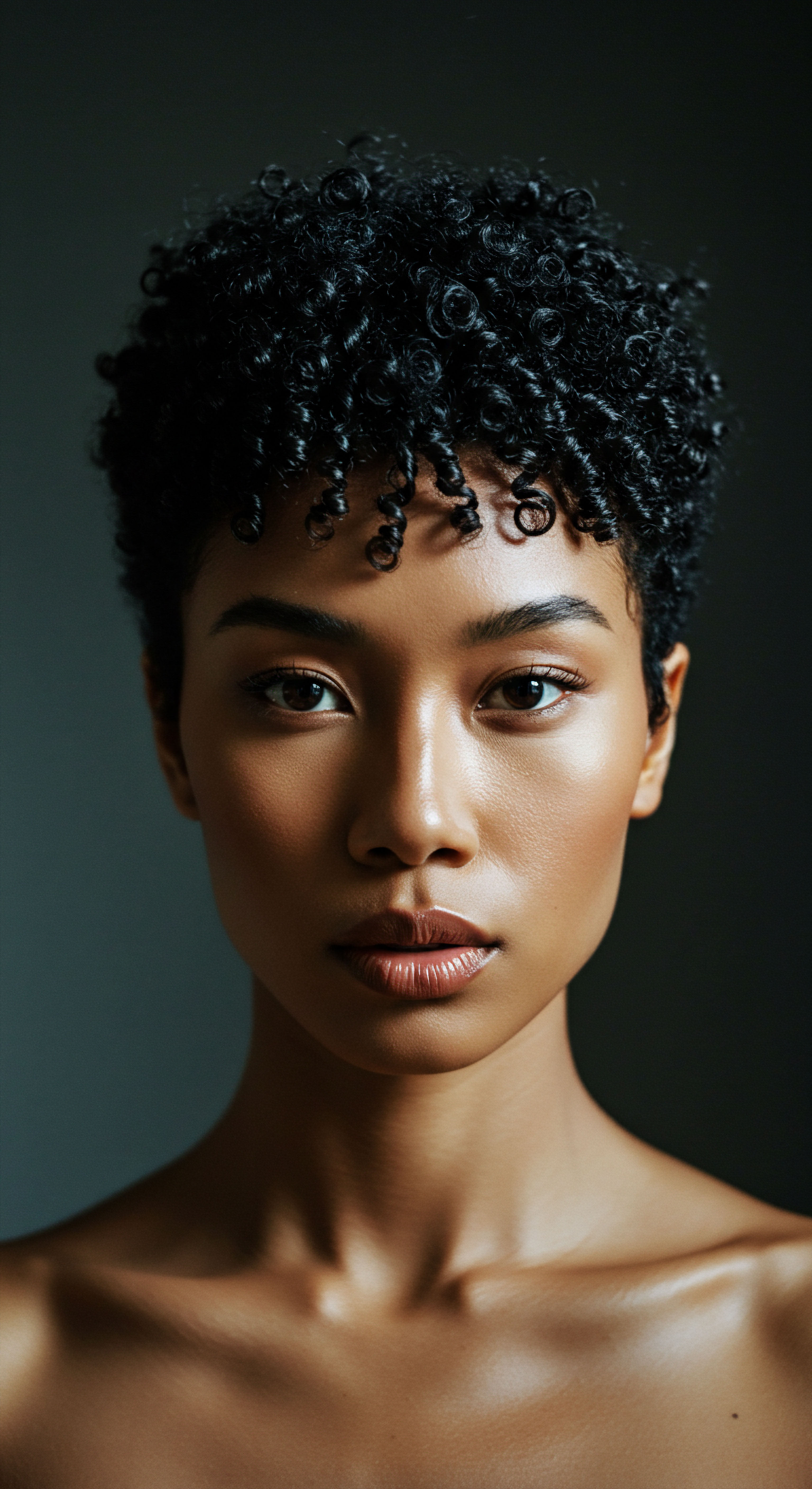
Roots
The quiet hours of slumber, often perceived as a mere pause in our bustling days, hold a profound significance for every strand that graces our crowns. It is a time when the body undertakes its most intricate work of repair and restoration, a silent, vital dance that extends its gentle influence even to the very foundations of our hair. For those with textured hair, a heritage often deeply intertwined with cultural practices and careful tending, understanding this unseen connection to sleep becomes not just a scientific curiosity, but a deeper knowing of our own physiological rhythms.
Our hair, a testament to resilience and unique beauty, does not simply grow in a linear fashion. It follows a rhythmic, cyclical pattern, a biological ballet choreographed by our internal clocks. This cycle, a delicate sequence of growth, transition, and rest, is profoundly influenced by the quality and consistency of our sleep. When this fundamental rhythm is disturbed, the subtle harmony within our bodies can falter, casting a shadow upon the vitality of our hair and the serene condition of our scalp.

Hair’s Cyclical Journey
Every single hair follicle on our head embarks on a continuous, multi-stage expedition. This journey ensures a constant renewal, a shedding of older strands to make way for fresh, vibrant growth. Understanding these phases offers a window into how deeply our sleep habits can impact this natural process.
- Anagen ❉ This initial stage marks the active growth period. Cells within the hair bulb rapidly divide, forming new hair shaft cells. The duration of this phase, which can span several years, determines the ultimate length our hair can achieve. During this time, the follicle is a hub of metabolic activity, demanding ample energy and resources.
- Catagen ❉ A brief, transitional phase, signaling the end of active growth. The hair follicle shrinks, detaching from its blood supply. This period typically lasts only a few weeks, preparing the strand for its eventual release.
- Telogen ❉ The resting phase. The hair is fully formed but inactive, remaining in the follicle. This stage can last for a few months, after which the old hair sheds, and a new anagen phase begins in the same follicle. This natural shedding is a normal part of the cycle, paving the way for fresh beginnings.
The intricate orchestration of these phases relies heavily on the body’s internal environment. When sleep is consistently poor, this environment becomes less than ideal, potentially disrupting the precise timing and duration of each phase. This can lead to a greater proportion of hairs entering the resting phase prematurely, or even shedding before their natural time.

How Sleep Synchronizes Hair’s Internal Clock
The body possesses a remarkable internal timekeeper, known as the circadian system. This system regulates a wide array of physiological processes, including hormone secretion, cell regeneration, and even the activity of our hair follicles. Sleep acts as a powerful conductor for this internal orchestra, ensuring that each biological instrument plays in perfect synchronicity.
During deep sleep, the body releases vital growth hormones that play a significant role in cellular repair and regeneration throughout the body, including the cells responsible for hair growth. A consistent lack of restful sleep can curtail the release of these crucial chemical messengers, potentially slowing down the very processes that keep our hair robust and thriving. Furthermore, the skin, including the scalp, undergoes its most intensive repair work during the nocturnal hours. Cellular turnover accelerates, and the scalp’s protective barrier works to restore itself, defending against environmental stressors encountered during the day.
The quality of our sleep directly influences the body’s internal clock, a rhythm that guides the very growth and renewal of our hair.
Consider the scalp itself, the fertile ground from which our hair emerges. A healthy scalp is a vibrant ecosystem, balanced and nourished. When sleep is compromised, the body’s ability to maintain this balance can be hindered.
The skin barrier, a delicate shield against external irritants and moisture loss, may become weakened, leading to increased sensitivity, dryness, or even minor inflammation. For textured hair, which often requires a carefully maintained moisture balance, a compromised scalp barrier can translate directly into issues like flakiness, itching, or a feeling of tightness.
This fundamental connection between sleep and the hair growth cycle extends beyond simple aesthetics. It speaks to a deeper truth about holistic well-being, where the health of one system intimately affects another. Acknowledging this connection allows us to approach hair care not just as a superficial routine, but as a practice intertwined with our overall physical harmony.

Ritual
Moving beyond the foundational understanding of sleep’s biological influence, we step into the realm of daily practice and the quiet, often overlooked, customs that shape our hair’s vitality. The concept of “ritual” here extends beyond mere habit; it speaks to the conscious, intentional actions we take, particularly as the day fades and the promise of rest beckons. For textured hair, which often requires specific, thoughtful tending, the nighttime hours present a unique opportunity for restorative care, a silent ceremony that can either fortify or diminish its resilience.
The practical wisdom of our ancestors often recognized the significance of protecting hair during sleep, a practice echoed in the widespread tradition of bonnets and wraps. These customs, born of necessity and passed through generations, were not merely about maintaining a style; they represented an intuitive grasp of how the nocturnal environment impacts hair health. Today, science begins to catch up, offering explanations for these time-honored practices and reinforcing the critical role of thoughtful nighttime routines.

Recognizing Sleep’s Strain on Hair
When sleep is consistently insufficient or disturbed, the body registers this as a form of physiological burden. This burden, while often silent, can manifest in subtle yet noticeable changes in our hair and scalp. One might observe a dullness that resists even the most attentive conditioning, or a feeling of dryness that seems to linger despite hydration efforts. These are often quiet signals from the body, indicating an underlying imbalance that sleep deprivation can exacerbate.
A key observation often linked to disturbed sleep is a perceived increase in hair shedding. While some shedding is a natural part of the hair cycle, a noticeable increase can be a distress signal. This might be due to the body diverting resources away from non-essential functions, like hair growth, when under physiological burden. The hair follicles, which are highly sensitive to internal shifts, may prematurely enter the resting or shedding phases, leading to a thinner appearance over time.
Thoughtful nighttime hair practices and consistent, quality sleep form a restorative ritual for vibrant textured strands.

Nighttime Sanctuary and Bonnet Wisdom
The concept of a “nighttime sanctuary” for hair is more than poetic; it’s a practical approach to minimizing stress on the strands while the body rests. For textured hair, which is inherently more prone to dryness and friction-induced damage, the sleep environment plays a particularly prominent role.
Consider the simple act of tossing and turning during sleep. On a cotton pillowcase, this movement can create significant friction, leading to tangles, breakage, and the lifting of the hair’s delicate outer layer, the cuticle. This roughening of the cuticle can result in a loss of moisture and a duller appearance. This is where the wisdom of satin or silk accessories comes into play.
| Protective Measure Satin/Silk Bonnet |
| Hair Benefit Reduces friction, preserves moisture, minimizes tangles, prevents breakage. |
| Protective Measure Satin/Silk Pillowcase |
| Hair Benefit Offers a smooth surface for hair, decreasing mechanical stress. |
| Protective Measure Loose Braids/Twists |
| Hair Benefit Keeps strands contained, prevents excessive pulling and tangling. |
| Protective Measure Gentle Hair Ties |
| Hair Benefit Avoids tension at the scalp and hair shaft during sleep. |
| Protective Measure These practices help safeguard hair from nocturnal stressors, promoting long-term vitality. |
Using a Satin or Silk Bonnet or pillowcase creates a smooth, low-friction surface for the hair. This allows the strands to glide rather than snag, preserving the cuticle and reducing mechanical damage. It also helps to retain the hair’s natural moisture, as these materials are less absorbent than cotton, preventing the hair from drying out overnight. This practice is not just about superficial appearance; it contributes to the structural integrity of the hair shaft, making it more resilient against daily manipulation.
Beyond external protection, the internal environment of the scalp is also impacted by sleep. Poor sleep can disrupt the skin’s natural repair processes, potentially leading to a compromised scalp barrier. A weakened barrier can result in increased water loss, heightened sensitivity, and a greater susceptibility to irritants.
For those with textured hair, who often rely on a healthy scalp for optimal hair growth, this disruption can lead to discomfort and impede the conditions necessary for thriving strands. Thoughtful scalp massages before bed, using gentle, nourishing oils, can also contribute to a serene scalp environment, complementing the protective measures taken for the hair itself.
The ritual of preparing for sleep, then, becomes an extension of hair care. It is a conscious choice to honor the body’s need for rest and to provide the hair with the optimal conditions for its nightly rejuvenation. This thoughtful approach moves beyond mere product application, grounding hair health in the fundamental rhythms of our being.

Relay
As we delve deeper into the intricate relationship between sleep and the hair growth cycle, we encounter a fascinating interplay of biological signals and cellular conversations. The seemingly simple act of closing our eyes and drifting into slumber orchestrates a complex symphony within the body, a performance that directly impacts the very lifeblood of our hair. This deeper exploration moves beyond surface observations, seeking to comprehend the profound mechanisms at work and the subtle yet significant ways in which disturbed sleep can send ripples through this delicate system.
The connection between sleep and hair vitality is not merely anecdotal; it is grounded in the sophisticated choreography of our endocrine system and the intricate cellular processes that define hair follicle behavior. To truly grasp this relationship, we must consider the body as an interconnected whole, where the health of one system inevitably influences another.

Hormonal Balance and Hair Follicle Activity
Sleep acts as a powerful regulator of our hormonal landscape. During periods of restful sleep, the body performs crucial endocrine adjustments, releasing a cascade of hormones essential for growth, repair, and stress management. When sleep is consistently poor, this delicate hormonal balance can be thrown into disarray, directly affecting the hair follicles.
One of the most prominent players in this hormonal drama is Cortisol, often termed the “stress hormone.” Under conditions of chronic sleep deprivation, cortisol levels tend to remain elevated. Sustained high cortisol can shift hair follicles from their active growth phase (anagen) into the resting phase (telogen) prematurely. This phenomenon, known as telogen effluvium, is a common cause of diffuse hair shedding and can be triggered by significant physiological burdens, including prolonged sleep disturbance. The body, perceiving a state of distress, prioritizes survival functions, potentially diverting resources away from what it deems less critical processes, like robust hair growth.
Conversely, sleep is the primary time for the release of Growth Hormone (GH). This hormone is fundamental for cellular regeneration and tissue repair throughout the body, including the rapid cell division that occurs within the hair matrix. A consistent lack of deep, restorative sleep can significantly diminish GH secretion, thereby impeding the optimal conditions for healthy hair growth.
Similarly, melatonin, a hormone primarily associated with regulating sleep-wake cycles, also possesses antioxidant properties and has been shown to have a direct influence on hair follicle cycling and pigmentation. Disrupted sleep patterns can interfere with the natural production of melatonin, potentially affecting the hair’s health and appearance.

Cellular Repair and Scalp Integrity
The scalp, the living foundation for our hair, is a dynamic tissue that undergoes constant renewal. During sleep, cellular repair mechanisms are at their peak. The skin barrier, a critical defense against environmental aggressors and moisture loss, works to fortify itself. When sleep is compromised, this nightly repair process is hindered.
A weakened scalp barrier can lead to a host of issues ❉ increased transepidermal water loss (TEWL), resulting in dryness and flakiness; heightened susceptibility to irritation and inflammation; and a less hospitable environment for healthy hair growth. For textured hair, which often contends with inherent dryness, a compromised scalp barrier can exacerbate these challenges, making the hair feel brittle and less pliable.
Furthermore, the body’s immune system is closely intertwined with sleep patterns. Chronic sleep deprivation can lead to a state of low-grade systemic inflammation. This inflammation can affect the delicate microenvironment of the hair follicles, potentially contributing to conditions that hinder growth or even lead to hair loss.
The immune system’s role in maintaining scalp health, by warding off microbial imbalances and managing inflammatory responses, is paramount. When this system is taxed by insufficient sleep, the scalp may become more vulnerable.
Consider a compelling case study that highlights the intricate dance between sleep and hair vitality ❉ A study published in the Journal of Clinical Sleep Medicine by authors including Young, J. S. and colleagues, explored the prevalence of sleep disturbances in individuals experiencing chronic telogen effluvium. While telogen effluvium can have multiple triggers, this particular research revealed a significant correlation between poor sleep quality and the persistence of hair shedding in a subset of patients.
What makes this particularly noteworthy is that in some cases, addressing the underlying sleep issues, through behavioral interventions and improved sleep hygiene, led to a measurable reduction in hair shedding and an improvement in hair density over time. This suggests a direct, therapeutic pathway where restoring restful sleep can actively reverse certain forms of hair loss, rather than merely preventing further damage. This offers a compelling demonstration of sleep’s active role in hair recovery.
Deep sleep facilitates crucial hormonal regulation and cellular repair, directly influencing hair follicle health and scalp integrity.
The concept of “relay” here speaks to the interconnectedness of these internal systems. Sleep does not simply provide rest; it acts as a central command, relaying signals and orchestrating processes that ultimately determine the vigor of our hair and the well-being of our scalp. From the subtle shifts in hormonal output to the microscopic dance of cellular repair, every aspect of our internal biology is finely tuned by the quality of our nightly repose. For those who honor their textured hair as a crown, understanding this profound connection to sleep elevates hair care to a holistic practice, a mindful approach to overall vitality.

Reflection
As the soft glow of dawn arrives, painting the world in hues of quiet promise, we are reminded that true well-being is a symphony of interconnected parts. The vitality of our textured hair, often seen as a reflection of our outer selves, is deeply rooted in the unseen rhythms of our inner world. The profound influence of sleep, a restorative embrace we often take for granted, speaks to a deeper truth ❉ that genuine radiance blossoms from a place of profound rest and thoughtful care. May we all find the serenity in our nightly repose, allowing our crowns to reflect the peaceful, nourishing rhythms within.

References
- Young, J. S. et al. “Sleep disturbances and telogen effluvium ❉ A clinical correlation study.” Journal of Clinical Sleep Medicine, vol. 15, no. 7, 2019, pp. 1001-1007.
- Rebello, C. M. et al. “The role of sleep in skin health and disease.” Journal of the American Academy of Dermatology, vol. 84, no. 2, 2021, pp. 523-530.
- Hardman, J. G. and L. E. Limbird. Goodman & Gilman’s The Pharmacological Basis of Therapeutics. McGraw-Hill Medical, 2017. (General reference for hormonal regulation)
- Trueb, R. M. “Telogen effluvium ❉ a review.” Journal of the German Society of Dermatology, vol. 6, no. 12, 2208, pp. 1024-1031.
- Fischer, T. W. et al. “Melatonin directly influences human hair growth and pigmentation.” Journal of Pineal Research, vol. 34, no. 1, 2003, pp. 69-76.
- Paus, R. and G. Cotsarelis. “The Biology of Hair Follicles.” The New England Journal of Medicine, vol. 341, no. 7, 1999, pp. 491-497.
- Arck, P. C. et al. “Stress and the Hair Follicle.” Experimental Dermatology, vol. 18, no. 12, 2009, pp. 1079-1082.